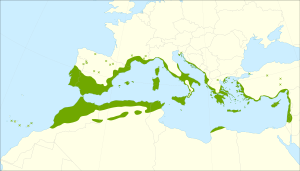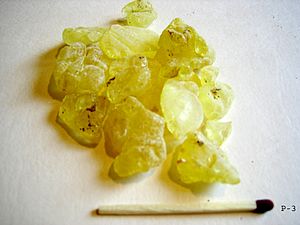Lentisk facts for kids
Quick facts for kids Lentisk |
|
|---|---|
 |
|
| Mastic foliage and fruit | |
| Conservation status | |
| Scientific classification | |
| Genus: |
Pistacia
|
| Species: |
lentiscus
|
 |
|
| Distribution | |
The Pistacia lentiscus plant, also known as the lentisk or mastic tree, is an evergreen shrub or small tree. It belongs to the Pistacia family. This plant is native to the Mediterranean Basin, which is the area around the Mediterranean Sea.
The mastic tree can grow up to 4 meters (about 13 feet) tall. It is grown for its special aromatic resin. This resin is mostly collected on the Greek island of Chios and near the Turkish town of Çeşme.
Contents
About the Mastic Tree
This plant stays green all year round. It usually grows between 1 and 5 meters (3 to 16 feet) tall. It has a strong resin smell. You can find it in dry, rocky areas across North Africa and Mediterranean Europe.
The mastic tree can handle mild to strong frosts. However, it prefers milder winters. It grows well in all kinds of soil, even in areas with limestone or salty soil near the sea. This plant is common in woodlands, open pastures called dehesas, and shrublands. It also grows on hills, in gorges, and on rocky slopes throughout the Mediterranean region.
It is often found with other Mediterranean plants like myrtle, Kermes oak, and Mediterranean dwarf palm. The mastic tree provides shelter and food for birds and other animals. It is a very tough plant that birds help to spread.
As it gets older, the mastic tree can grow large trunks and many thick branches. If left alone, it can become a tree up to 7 meters (23 feet) tall. But often, cutting, grazing animals, and fires stop it from growing so big.
The leaves of the mastic tree grow in an alternating pattern. They are leathery and made up of several small leaflets arranged in pairs. This means they have no single leaflet at the very end. Each leaf has five or six pairs of dark green leaflets.
The plant has very tiny flowers. Male flowers have five stamens (the parts that make pollen). Female flowers have a three-part style (the part that receives pollen). The fruit is a small, round fruit called a drupe, like a cherry. It starts red and turns black when it is ripe. Each fruit is about 4 millimeters (0.16 inches) wide. The fruit is edible, but people do not usually eat it. It tastes a bit tart, like raisins.
The Pistacia lentiscus is related to another plant called Pistacia terebinthus. They often mix and create hybrid plants where their growing areas meet. The Pistacia terebinthus is more common in mountains and inland areas. The mastic tree is found more often near the sea, where the climate is milder. The mastic tree does not grow as large as the Pistacia terebinthus.
You can tell the mastic tree apart because its leaflet stalks are flat and have small "wings" on the sides. The stalks on Pistacia terebinthus are simple. On the west coast of the Mediterranean, in the Canary Islands, and in the Middle East, the mastic tree can sometimes be mistaken for P. atlantica.
Where it Grows
The Pistacia lentiscus is found naturally all over the Mediterranean area. This includes places from Morocco and the Iberian peninsula in the west, through southern France and Turkey, to Iraq and Iran in the east. It also grows naturally in the Canary Islands.
Used in Gardens
In cities near the sea, the mastic tree is often planted in gardens and resorts. People like it because it is strong and looks nice. Unlike other Pistacia species, it keeps its leaves all year. It has also been brought to Mexico as a garden plant. There, it has started to grow wild, especially in dry suburban areas. It does well there even though Mexico's summer rain is different from the Mediterranean climate.
Mastic Resin
The mastic tree produces an aromatic, ivory-colored resin. This resin is also called mastic. It is collected as a spice from cultivated mastic trees. These trees are grown in the southern part of the Greek island of Chios in the Aegean Sea. On Chios, the resin is known as "Chios tears."
The resin is first a liquid. When the weather gets cold, it hardens into drops or flat pieces. These pieces are hard, brittle, and clear. When you chew the resin, it softens and becomes a bright white, opaque gum.
The word "mastic" comes from the Latin word masticare, which means "to chew." In Greek, the verb mastichein means "to gnash the teeth" or massein means "to chew."
In the European Union, mastic from Chios has special protection. It is given "protected designation of origin" and "protected geographical indication" names. This means only mastic from Chios can use these names. Even though the tree grows all over the Mediterranean, it only releases its resin in certain places. The most famous places are around Cesme, Turkey, and in southern Chios, Greece. Chios is the only place in the world where it is regularly grown for its resin. The mastic production on Chios is managed by a group of old villages. These villages are known as the 'mastichochoria', which means "mastic villages."
How Mastic is Collected
The resin is collected by making small cuts in the bark of the main branches of the trees. The sap then drips onto specially prepared ground below. This harvesting happens during the summer, between June and September. After the mastic is collected, it is washed by hand. Then, it is left to dry away from the sun, because the sun would make it melt again.
Mastic resin is a fairly expensive spice. People have used it as a chewing gum for at least 2,400 years. Its flavor is strong, a bit smoky, and tastes like resin. It can be an acquired taste, meaning you might need to try it a few times to like it.
Some experts believe the word bakha mentioned in the Bible, like in the Valley of Baca in Psalm 84, refers to the mastic plant. The word bakha seems to come from the Hebrew word for crying or weeping. This might refer to the "tears" of resin that drip from the mastic plant. It also refers to a sad weeping sound that happens when branches are broken or walked on. The Valley of Baca is thought to be a valley near Jerusalem covered with small mastic shrubs.
Mastic was popular in Roman times, and children would chew it. In the Middle Ages, it was highly valued for the sultan's royal family. They used it to freshen breath and for cosmetics. It was a special privilege for the sultan to chew mastic, and people thought it had healing powers. When Chios became part of the Ottoman Empire, mastic became even more widely used. It is still popular in North Africa and the Near East today.
Mastic in Cooking
Mastic gum is mainly used for its flavor or its gum-like qualities, like in mastic chewing gum.
As a spice, it is still used in Greece to flavor drinks like mastiha (a Greek liqueur). It is also used in chewing gum, cakes, pastries, spoon sweets, and desserts. Sometimes, it is even used in making cheese. Mastic resin is a key ingredient in dondurma (Turkish ice cream) and Turkish puddings. It gives these sweets their unique texture and bright white color.
In Lebanon and Egypt, mastic is used to flavor many dishes, from soups to meats to desserts. In Morocco, smoke from the resin is used to flavor water. In Turkey, mastic is a flavor for Turkish delight. Recently, a mastic-flavored fizzy drink called "Mast" was also created.
Mastic resin is an important ingredient in Greek festival breads. Examples include the sweet bread tsoureki and the traditional New Year's vasilopita. Mastic is also essential for myron, which is a holy oil used in ceremonies by Orthodox Churches.
Mastic is still used for its gum and medicinal properties, as well as in cooking. A chewing gum company in Jordan, Sharawi Bros., uses mastic from this shrub as a main ingredient in their mastic-flavored gums. They sell this gum to many stores worldwide. The resin is also a main ingredient in cosmetics like toothpaste, hair and skin lotions, and perfumes.
Mastic in Medicine
People in the Mediterranean region have used mastic as a medicine for stomach problems for thousands of years. A Greek doctor and botanist named Dioscorides wrote about mastic's medicinal uses in his book De Materia Medica (About Medical Substances) in the first century. Later, other doctors also noted how mastic helped the digestive system.
Mastic oil has properties that fight bacteria and fungi. Because of this, it is often used in ointments for skin problems. It is also used to make medical plasters.
In recent years, scientists at universities have studied mastic's medicinal properties. A 1985 study found that mastic can reduce bacteria in dental plaque in the mouth by 41.5%. Another study in 1998 found that mastic oil has antibacterial and antifungal properties. A different study in 1998 suggested that mastic might help heal peptic ulcers. It does this by killing Helicobacter pylori, a type of bacteria that causes ulcers, gastritis, and duodenitis. Some studies showed that mastic gum did not affect H. pylori if taken for a short time. However, a more recent and larger study showed that mastic gum did reduce H. pylori if a certain sticky part was removed and if it was taken for a longer time.
Other Uses
Besides its medicinal, cosmetic, and cooking uses, mastic gum is also used to make high-quality varnish.
The mastic tree has been brought to Mexico as an ornamental plant. It is very popular there and has become fully naturalized, meaning it grows wild. The trees are mostly grown in suburban areas in dry regions. They remain healthy even though the summer rainfall there is different from its original Mediterranean climate.
A related species, P. saportae, is a hybrid plant. DNA analysis shows it is a mix of the maternal P. lentiscus and the paternal P. terebinthus (also called terebinth or turpentine). This hybrid has leaves with leaflets that are somewhat persistent and sometimes reduced. Usually, P. terebinthus and P. lentiscus grow in different natural areas and do not often overlap. Mastic grows at lower elevations and near the sea, while P. terebinthus is more often found inland and in mountainous areas.
See also
 In Spanish: Lentisco para niños
In Spanish: Lentisco para niños
- False mastic
- Greek cuisine
- Greek food products
- Mastic (plant resin)
- Mastichochoria
- Turkish cuisine





